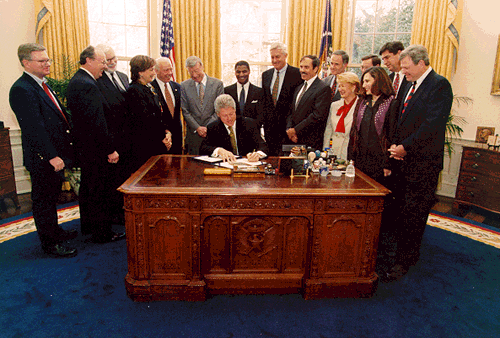
President Clinton signs Amtrak Reauthorization Bill December 2,
1997. Second on right is BMWE President Mac A. Fleming and at far left is BMWE General
Chairman Jed Dodd.
When the votes were counted on December 5, BMWE members had overwhelmingly approved the
agreement between the BMWE and Amtrak. Of a high 65 percent return, 83.2 percent voted in
favor of the agreement.
The struggle to win this respectable agreement, one that provides members with increases
nearly identical to what members on the freight railroads received last year, was more
difficult because of the simultaneous battle being waged in Congress to get funding for
Amtrak.
When Amtrak went to Congress for appropriations, they didn't even ask for the increases
for their work force which the national freight agreement provided. Worse, they continued
to bow to political pressure by agreeing publicly to the wholly unrealistic
"plan" for no operational subsidy by the year 2002.
So with congressional opponents to Amtrak reauthorization attacking the BMWE's demands in
the background and Amtrak, under the leadership of CEO Tom Downs (who unexpectedly left
Amtrak in December), refusing to bargain in good faith, the BMWE prepared to strike.
At this juncture BMWE developed a strategy designed to provide an acceptable agreement for
our Amtrak members while accommodating Amtrak's needs and protecting the riding public on
the commuter railroads which were not party to the BMWE/Amtrak dispute.
This innovative move--seeking and reaching agreement with commuter roads to permit them to
continue to provide service in the event of an Amtrak shutdown--demonstrated BMWE's
recognition that if they shut the commuter roads down too, they would injure hundreds of
thousands of commuters who were not party to the dispute. A byproduct of this desire to
serve the public was gaining key political support in Congress.
BMWE also believes that this move encouraged Secretary of Transportation Rodney Slater,
who had been working diligently to keep the parties at the bargaining table, about the
good faith position of the BMWE.
On November 13, the BMWE along with the rest of rail labor gained a brief respite from
their efforts to assist in the battle to keep Amtrak funded, when Congress adopted a
compromise $3.4 billion appropriation for Amtrak that will provide the nation's rail
passenger carrier with enough money to keep operating into the beginning of the 21st
century.
Although rail labor accepted the bill as the best that could be achieved in this Congress,
leaders were not happy with the outcome.
Particularly upsetting in the new law are changes to labor protection (known as C-2
Protection) that were strongly opposed by all of rail labor. The law requires Amtrak
management and labor to negotiate a new labor protection agreement within 180 days. After
that time, C-2 Protection will be removed from the law. The BMWE is actively participating
on a joint rail labor committee concerned with the C-2 Protection issue.
On another issue, contracting out, limitations were removed from the law but they were
placed in collective bargaining agreements, subject to future negotiations.
The fundamental problem that persists is Congress' lack of commitment to Amtrak's
continued viability. The constant bending to perceived political winds keeps putting the
workers' and the public's welfare in jeopardy.
On the positive side, there are representatives in Congress like Jim Oberstar (D-MN) who
led the House fight to protect Amtrak workers' jobs and Sen. John Kerry (D-MA) who worked
hard to preserve basic employee rights.
Kerry gave some interesting facts during the debate on the issue in November. "While
we in Congress have argued over whether the Federal Government should or shouldn't ensure
a healthy inter-city rail system, internationally it is no secret that a well-founded rail
network is an essential ingredient of a strong 21st century economy.
"In fact, every major economic power, except the United States, invests several
billions of dollars annually in passenger rail transportation. The European Union plans to
invest more than $100 billion to better utilize and integrate its multi
billion-dollar-rail network. And our economic competitors in Asia, including China,
Taiwan, Malaysia, and South Korea, are all investing heavily in rail.
"The unfortunate truth is that on a per capita basis, at least 34 countries,
including Guinea, Myanmar, South Africa, Iran, and Botswana each spend more than the
United States on passenger rail. In this light, which I think is the correct light in
which to view what we are doing today, we are doing the bare minimum necessary to ensure
continued passenger rail travel in the United States and to maintain a vibrant national
transportation network. ..."
Gallup Poll: 69% Favor Amtrak Funding
An October 27 Gallup Poll sponsored by CNN and USA Today asked whether "the
federal government should continue to provide funding for the cost of running Amtrak, in
order to ensure that the U.S. has a national train service, or the federal government
should stop funding Amtrak, even if that means the train service could go out of business
if it doesn't operate profitably on their own."
Favoring continued funding were 69% of respondents, with 26% against (and 6% other
responses).
From News from the National Association of Railroad Passengers October-November
1997. |

